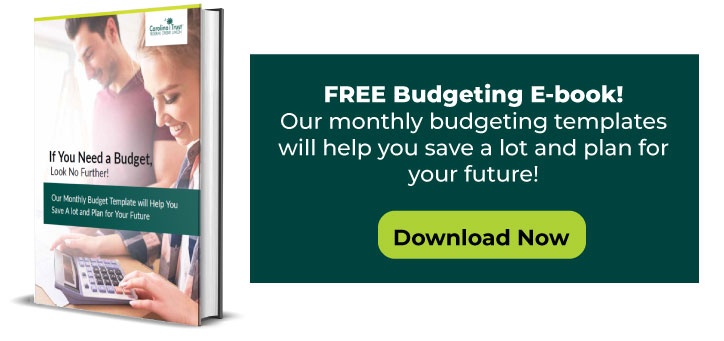Budgets are a valuable money management tool. Even if you’re happy with your financial health, budgets can keep you from slipping into bad habits. They can even help you save a lot of money. If you’re struggling to make ends meet, budgeting is an excellent way to get control of your spending.
If the word budget makes you think of never-ending columns and rows, don’t worry. There are budgeting methods that make it easier to manage your finances once a budget template is in place. There are even budgeting apps for your smartphone that can keep you on track.
Step 1. Collecting Financial Records for a Budget Template
First, collect financial records on the money you make (income) and the money you spend (expenses).
Income Sources
The following documents may contain information on the income you receive.
- Bank statements
- Investment accounts
- W-2s
- 1099s
- Social Security checks
- Pension distributions
- Alimony and child support
- Rental income
- Unemployment benefits
After you’ve collected your income records, you’ll need to collect receipts, invoices, or debit/credit card statements to determine your expenses.
Expenses
First, assemble your fixed expenses. These are the bills you pay every month such as the following
- Utilities such as gas, water, and electric
- Credit card bills
- Mortgage or rent payments
- Loan payments such as a car or student loan
- Transportation costs may include gas or the cost of using public transit
- Insurance
- Child care if you need it to work
Next, you will need to determine your variable expenses. These expenses vary from month to month. Some of these expenses may be more of a want than need. Yes, you need to eat, but do you need to eat out every night? If you have trouble separating needs from wants, you need a budget.
- Food
- Travel
- Vacations
- Entertainment
- Clothes
- Memberships
Deciding what is a want and what is a need won’t be the same for everyone. For example, a high-speed internet connection may be required if you work from home; but a lower speed connection may be sufficient for surfing the web. Or, you may be willing to sacrifice a night out with friends to have money for a new coat.
Step 2. Calculating Your Income
You can use pencil and paper to create a budget, or you can use a spreadsheet to do the calculations for you. Whatever method you choose, you’ll need to know how much income you receive each month.
- If you receive a regular paycheck with all taxes deducted, your take-home pay is your net income.
- If you have other income sources such as child support or Social Security, include the per month income you receive.
- If you receive retirement or rental income, add that to your monthly income.
If you’re part of the gig economy or a seasonal worker, you have a variable income. Developing a budget template can save a lot of headaches. The best way to determine a monthly income is to use the lowest-earning month as your baseline monthly income.
TIP: Be sure to list each source of income separately. It will make it easier to track and update when something changes. Like you get a raise!
Step 3. Setting Up Your Fixed Expenses on Your Budget Template
Fixed expenses are those bills that appear every month, such as the following:
- Utilities
- Credit card bills
- Mortgage or rent payments
- Loan payments
- Transportation
- Insurance
- Child care
It may take a little more time, but it’s better to list expenses separately. Instead of entering a single amount under utilities, list each utility and the amount. That way, it’s easier to identify which utility needs adjusting.
Some utility companies offer a monthly payment plan that allows you to pay a flat fee each month. That can make it easier to budget. Just remember to look at the bill once in a while to make sure your monthly amount doesn’t need to change.
Irregular Expenses
Irregular expenses are bills that are due at predictable times every year. They may be insurance premiums that are due twice a year or an annual vehicle registration. Make a list of the irregular, fixed expenses and the amount.
TIP: If you can’t remember all your irregular expenses, look at your bank statements. If you use online bill pay, you should be able to identify the irregular expenses by the scheduled payment dates.
Total the irregular fixed expenses and divide by 12. This is the amount you should set aside. The easiest way to ensure that the money is there when you need it is to set up a separate savings account. Every month make a payment to the account. When an irregular bill comes due, you won’t have to scramble to come up with the money.
Step 4. Listing Your Variable Expenses
Look at the list of variable expenses:
- Food
- Travel
- Entertainment
- Clothes
- Memberships
Are there other items that need to be added? What about gifts? If you don’t put money aside for gifts, presents for friends and family could destroy a budget.
Review your expenditures from the last 12 months to determine what you paid on variable expenses. Be honest. If you think you may have overspent, don’t try to hide it. That’s why you need a budget - to better manage your finances.
TIP: If you feel that groceries should be part of your fixed expenses, separate groceries from take-out or dining out. Total the amount spent on groceries for six months and divide by six. That is the monthly budget amount to use for groceries.
Step 5. Total Expenses
Now you’re ready to total your expenses. Some people prefer to separate fixed from variable expenses. If you’d like to keep them separate, subtotal the fixed and variable expenses before creating a grand total. Subtract your total expenses from the income you calculated in Step 2.
- If you have income remaining, put money aside for a rainy day fund, pay off debt, or start saving for retirement.
- If you do not have enough income to cover expenses, make adjustments to lower your expenses.
Consider cutting back on variable expenses by eating out less or canceling a membership. You may need to consider adding income if you can’t eliminate expenses so that your expenses are less than your income.
TIP: To cut expenses, look at refinancing your home or finding a cheaper phone or cable plan. Compare internet providers for the best deals. Even small changes add up. Skipping a $5.00 cup of coffee on your way to work lowers your monthly expenses by $100.
Emergency Fund
You need an emergency fund to cover unexpected expenses such as car or home repairs. Try to keep the emergency fund around $1,000. If you don’t have a way to pay for emergencies, you will incur more debt to pay for unplanned expenses. Put some amount aside each month. Maybe it’s only $10.00, but it’s a start. Once you have an emergency fund, you’ll sleep better at night.
Budget Methods
There are different ways to budget because one size doesn’t fit all. Here are some of the more popular methods.
- Zero-based. With zero-based budgets, you want to have a zero balance when you subtract expenses from income. Expenses may include savings, retirement plans, or other investments. The goal is to have all of your income accounted for each month.
- 80/20. This method allocates 20% for savings and 80% for expenses. The 20% is taken off the top, and you live within the remaining 80%. At least 10% of the savings amount should go towards retirement.
- 50/30/20. This technique divides your budget into needs, wants, and savings. The goal is to have 50% of your income go to needs, 30 percent go to wants, and 20% to savings.
- Envelope-based. This approach is great for people who need a little help with spending. You create spending categories like coffee or dining out. Each category has an envelope, and you put cash into the corresponding envelope at the start of each month. When the envelope is empty, you’ll have to wait until the next month for it to be replenished.
Take a look at the different styles to find one that works for you. Then, look for an app or spreadsheet that aligns with your budget style.






